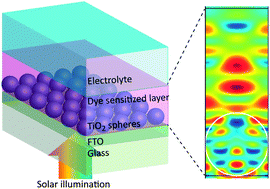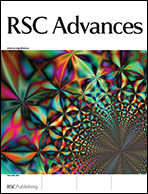Resonant-size spherical bottom scatterers for dye-sensitized solar cells†
Abstract
We numerically evaluate the effect of a monolayer of resonant-size TiO2 spheres on the performance of dye-sensitized solar cells (DSCs). This scattering layer is placed between the transparent conducting layer and the dye-sensitized mesoporous TiO2 layer. We carried out our numerical calculations by solving full-wave Maxwell equations in the entire DSC structure using the rigorous coupled-waves approach (RCWA). The layer of TiO2 spheres functions as a strong reflector, leading to strong confinement of the incident light within the absorbing layer of the DSC. The reflectance from this layer originates from coupling of light to the optical resonance modes of the TiO2 spheres. Comparing maximum achievable photocurrent densities of the DSC with TiO2 spheres relative to the standard planar DSC shows that this scattering layer enhances the cell performance as long as the thickness of the dye-sensitized layer stays below 6 μm. Therefore this photon management strategy is useful for solid-state DSCs with thin absorbing layers of up to 3 μm thick. This scattering layer can be used in combination with the widely applied top-scattering layers, leading to an upper limit of 150% and 60% enhancements in DSCs having a 1 μm and 3 μm thick sensitized layers if 600 nm TiO2 spheres are used.


 Please wait while we load your content...
Please wait while we load your content...